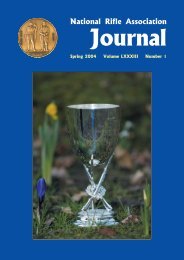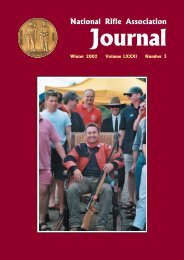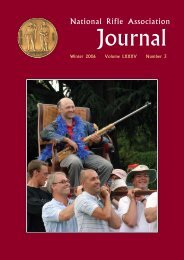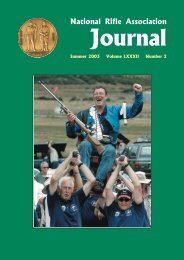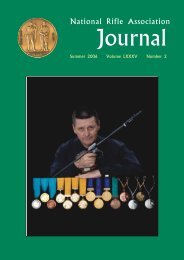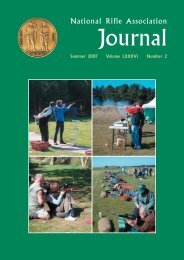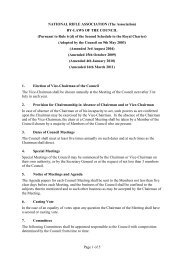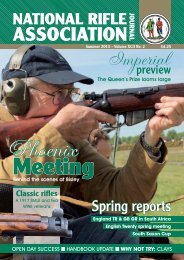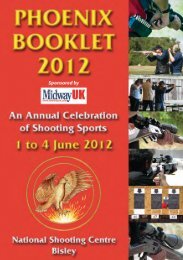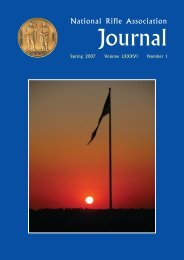The team's tour brochure. - National Rifle Association
The team's tour brochure. - National Rifle Association
The team's tour brochure. - National Rifle Association
You also want an ePaper? Increase the reach of your titles
YUMPU automatically turns print PDFs into web optimized ePapers that Google loves.
<strong>The</strong> first attempt failed to maintain the required stability and it collapsed.<strong>The</strong> rebuild suffereda similar fate so that the JRA were forced to change their courses of fire in all matches andchampionships, and the choice was whether to include 200 or 400 yards, or 300 metres. Frommemory, a bit of all three solutions was involved in their Championships.A note of interest inthe NRA Captain’s report of 1988 is that “next year more practice at 200 is required”; that yearthe JRA v NRA score was 597To 588 at 200 yards. In 1988 and 1989 they shot 15 shots at 300and 500, But Jersey continued the longest winning run, from 1981 to 1989.This was stopped in1990 when one of the few teams to win both matches on both islands <strong>tour</strong>ed under DavidCalvert’s captaincy.But back to the Crabbe range problem, a note of concern had been made when the increasein height was forced on the JRA, that it made the firing point far too narrow, front to back, forsafe occupancy by pretty much anyone other than the firers lying down.This gloomy note wasproved beyond doubt when the official inspection took place by the surveyor - his terrier felloff the top, thankfully without noticeable injury.Finally a solution was found for the collapsing 600 yard FP - move the whole range 20 yardstowards the sea, rebuild the butts and all the firing points! <strong>The</strong> States of Jersey were generousin their support of this project, perhaps as the local facility helps in generating the marksmenwho represent them on the world stage of <strong>The</strong> Commonwealth Games.With both Guernsey and Jersey ranges being very much “on the coast”, they suffer from anormal coastal climactic effect: wind, and lots of it. It is a feature of such wind that, althoughstrong, it is often remarkably steady in overall strength.<strong>The</strong> main feature that makes life difficultis that it will tend to be blustery so that, whilst the average “blustery effect” over the flight ofthe bullet down range smoothes the precise effect of the “blust” at any given point, thereremains the problem of the effects of this “blust” on the shooter himself who is trying to remainstill on the firing point.It is noticeable that a number of Channel Islanders and other successful visitors overcome thisby the simple expedient of using a double point sling, which many claim to reduce the lateraleffect of buffeting. Exponents of the double rather than single point sling include the late greatAndrew StG Tucker, Cliff Mallett, and no doubt many more but you have to rely on thisreporter’s memory.Andrew Tucker made the Jersey Autumn Meeting part of his personal shooting calendar. It wasa nice way to round off August; some great meals in fabulous restaurants, with a few relaxedshoots in convivial company to aid the digestion during the day. He won the Grand Aggregatefour times with impressively high scores. He only stopped going when the DCRA ConnaughtMeeting timetable slipped such that the Canada Team, of which he was often a member, wouldnot return in time for him to get to Jersey. It was rumoured that he would arrive at Heathrow,meet Cathy, who would swap suitcases with him and wave him off to Jersey. I believe this is farfetched as he only lived 20 miles from the airport, and I’m sure he would have gone home fora cup of tea whilst the suitcases were swapped by Cathy.<strong>The</strong> appeal of <strong>tour</strong>ing teams is not only to see other places and shoot, but also to meet thoseinteresting people who do not travel away from their homes to shoot. <strong>The</strong> “Bisleyite” whothinks all the great shots come to worship the art of shooting at Bisley are sadly mistaken.<strong>The</strong>re are hundreds, if not thousands of world class shots who enjoy the thrill of shooting wellat the local club, but are not interested in taking time away from home and family to see if theycould do it on a different range at <strong>National</strong> level. So there are many “Tyros” who due to theNRA’s system of classification will forever remain so because they have no desire to shoot atthe Imperial Bisley Meeting. However on their home soil they are as hard to beat as the bestthat Bisley, Connaught, General de Wet, Malabar, Raton or Trentham can produce. Crabbe andLancrett are no different. Looking through the names and scores of the Island teams one canidentify people who were content to be part of the local shooting fraternity, though family isperhaps a better word as we have masses of superb lady shooters who are sadly more rarelyseen away from their home range.<strong>The</strong> familiar family names give us the individuals who have performed most often in these seriesof matches; so far as I can tell, for Guernsey the most appearances have been by Courteney,Henry, Jory, Le Page, Martel, Perkins, Rowe andYeadon, and for Jersey Amy, Benest, Harris, Langley,Le Cheminant, Le Vesconte, Mallet, Norman and Payn.<strong>The</strong>se records are incomplete at the moment, and research shows that team details are missingfor much of the 1970s and 1990s.Also,, with ladies changing their surnames on changing theirmarital status, I may easily have overlooked some duplication of person through lack of familiarityof personalities.<strong>The</strong> records cover not only the eights, but also the Reserves matches.<strong>The</strong>se side matches onlystarted once the <strong>tour</strong>ists travelled with more than the basic team size.<strong>The</strong> scores in the matchalso mirror the changes in our sport, with the demise of the .303 at the end of the sixties anda choice of which calibre to use; there are notes of individual success and comments on whichcalibre was being used, and the new 7.62 out-shot the older .303.<strong>The</strong> difference was so markedthat target ring sizes were reduced quite considerably in 1974, again in 1988 and the v-bulltinkered-with in 1995.



